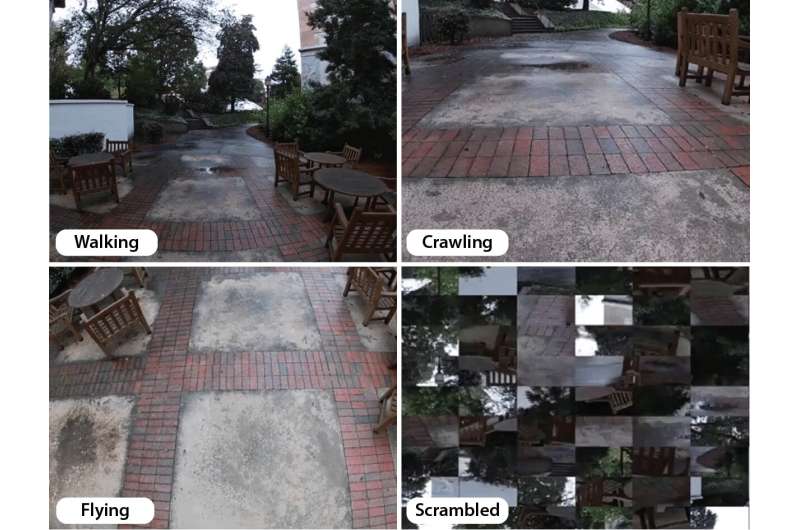This article has been reviewed according to Science X's editorial process and policies. Editors have highlighted the following attributes while ensuring the content's credibility:
fact-checked
peer-reviewed publication
trusted source
proofread
Visually navigating on foot uses a unique brain region

Using vision to efficiently move through an area by foot uses a unique region of the brain's cortex, according to a small study organized by the National Eye Institute (NEI). The region, called the occipital place area (OPA), fails to activate during other modes of moving, such as crawling. The finding may help explain developmental milestones as children learn to interact with and navigate their near environments. The study published in the journal Cerebral Cortex.
Navigating through a physical environment—anything from a small room to a city—requires the brain to process several classes of information. Each class of information is processed in its own region of the brain's cortex, which then work together to support navigation behavior, such as walking. Loss of any one of these regions can affect how or whether someone can successfully navigate.
Two main areas of the cortex are activated as people navigate through an environment: the OPA and the retrosplenial complex (RSC). Daniel Dilks, Ph.D., Emory University, Atlanta, theorizes that each of these areas supports a different kind of navigation. The RSC supports map-based navigation, which involves finding our way from a specific place to some distant, out-of-sight place (for example, finding our way from your house to your favorite restaurant).
By contrast, he believes the OPA supports visually guided navigation, which involves finding our way through near environment, avoiding boundaries and obstacles (for example, moving through your kitchen without bumping into things). However, his theory has been controversial, in part because the OPA doesn't appear to support visually guided navigation until around 8 years of age.
Yet children somehow manage to get around their homes and schools long before that time—even from the earliest ages, when they crawl rather than walk.
"We asked ourselves, does the OPA come on early but just mature slowly?" Dilks said. "Or does crawling use an entirely different system?"
While most adults and older children primarily navigate environments by walking, we retain the ability to crawl as we did in infancy. If OPA just matured slowly, then it should be activated by both modes of movement, Dilks reasoned. So, he and students Christopher Jones and Joshua Byland set out to discover whether the OPA would activate in adults when crawling.
To test this, the scientists recorded videos from the perspective of someone walking through an environment, and then similar videos from the perspective of someone crawling through that same environment. They also patched together random shots of the videos (scrambled) and took videos from a flying-over-the-environment perspective, to include a mode of navigation not accessible to humans.
When viewing videos, our brains often activate as if we were performing the activity ourselves—a sympathetic response that made Dilks' experiment possible. Using functional magnetic resonance imaging (fMRI), the researchers were able to monitor the activation of brain regions in 15 adult study participants as they were viewing each video and imagining themselves moving through the environment.
When the participants viewed the walking video, the region of the brain corresponding to the OPA was activated. But when they viewed the other videos—crawling, flying, or scrambled, OPA was not activated. In contrast, the RSC was activated when viewing all the videos, suggesting that only OPA is specific for walking, as opposed to other modes of visual navigation.
In addition, several other brain areas were activated when the participants viewed the crawling videos, suggesting additional regions that may be involved in navigation early in life.
"Not only does this study suggest that there's a completely different brain system managing navigation in early versus late childhood, but it suggests that each of these pieces of the navigation system come on at different stages of development," Dilks said. "Based on our study, we think OPA is specifically tied to mature, efficient walking."
More information: Christopher M Jones et al, The occipital place area represents visual information about walking, not crawling, Cerebral Cortex (2023). DOI: 10.1093/cercor/bhad055



















